How To Pack Up Your Kitesurfing Kite
How To Pack Up Your Kitesurfing Kite
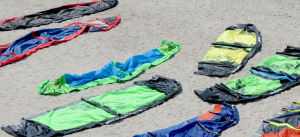
With the inane tendency of stock kitesurfing kite bags to continuously get smaller and smaller over the years (especially compared to my 2005 mesh Cabrinha sack), properly folding a kite becomes an important skill to have. Not only does it reduce the amount of time spent on the beach after a kiteboarding session, but allows you to pack your vehicle more efficiently and reduces unnecessary wear on your kite. While the technique may vary slightly depending on if your kite has a central deflation system or uses a dump valve, the general approach will remain largely uniform. There is something embarrassing about having to walk by your fellow kitesurfing compatriots with a clumsy, overstuffed kite bag. Fortunately, this dilemma is easily avoided by taking some extra care, much of which will help extend the longevity of your kite!
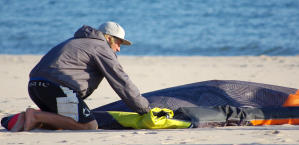 The first step is deflating your kitesurfing kite in the appropriate orientation to the wind. As you release the deflation or dump valve, allow the kite to drift downwind while holding onto one end of the leading edge. The canopy will naturally want to flow with the wind, and letting it blow that direction will help prevent the canopy from flapping and twisting while rolling. If the kite has sand on it, be sure to wipe it off before deflating. With the kite deflated, work the excess air out of the struts, pushing your hand from top to bottom to force the air out of the connecting tubes. Once all the struts are empty, begin rolling from the upwind wing tip of the kite. Some strongly advocate that the
The first step is deflating your kitesurfing kite in the appropriate orientation to the wind. As you release the deflation or dump valve, allow the kite to drift downwind while holding onto one end of the leading edge. The canopy will naturally want to flow with the wind, and letting it blow that direction will help prevent the canopy from flapping and twisting while rolling. If the kite has sand on it, be sure to wipe it off before deflating. With the kite deflated, work the excess air out of the struts, pushing your hand from top to bottom to force the air out of the connecting tubes. Once all the struts are empty, begin rolling from the upwind wing tip of the kite. Some strongly advocate that the 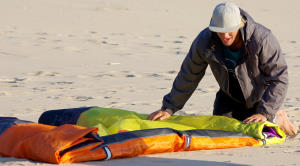 kite should be folded rather than rolled to prevent bladder twists inside the kite, but I personally haven't encountered that issue before, and it tends to be more time consuming. Make sure to roll tightly along the leading edge, and occasionally stop to straighten out the top of the kite, making sure the roll is tight like a crepe. Once you reach the middle of the kite, you are going to repeat the same process from the other end of the kite. If there is residual air in the kite, as you approach the center the other side may begin to unravel
kite should be folded rather than rolled to prevent bladder twists inside the kite, but I personally haven't encountered that issue before, and it tends to be more time consuming. Make sure to roll tightly along the leading edge, and occasionally stop to straighten out the top of the kite, making sure the roll is tight like a crepe. Once you reach the middle of the kite, you are going to repeat the same process from the other end of the kite. If there is residual air in the kite, as you approach the center the other side may begin to unravel 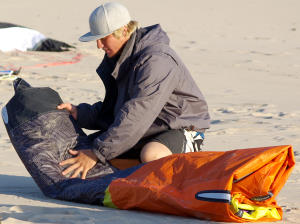 slightly, which can be prevented by setting your kiteboard on top or holding the first section down with one hand while slowly finishing rolling the second half. With the kite now tightly rolled to the center valves, you are going to want to fold the kite into thirds.
slightly, which can be prevented by setting your kiteboard on top or holding the first section down with one hand while slowly finishing rolling the second half. With the kite now tightly rolled to the center valves, you are going to want to fold the kite into thirds. 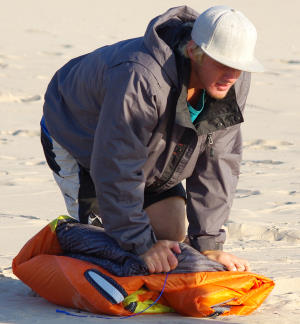 Start at the top of the canopy (opposite of the leading edge), and fold the kite once, and then over again, leaving you with a neat, compact square. If there is any excess air, you can try to squeeze it out by using your knee or hugging the kite to generate pressure.
Start at the top of the canopy (opposite of the leading edge), and fold the kite once, and then over again, leaving you with a neat, compact square. If there is any excess air, you can try to squeeze it out by using your knee or hugging the kite to generate pressure.
If the kite happens to have a dump valve near a wing tip on the kite (i.e. North), you'll want to follow the first part of the directions above, and just continue rolling until you reach the dump valve. From there you'll only have several feet left to roll on the opposite side. Likewise, if the kitesurfing kite has battens (i.e. North), the best method is folding the kite in half rather than thirds to prevent from bending and breaking the rods. With the folding done, tuck your kite neatly inside of the kite bag. Make sure the kite is completely in the bag to avoid accidentally zipping the canopy. For more tips, check out the video below produced by the Slingshot crew as to how to fold and pack a kite with ultimate efficiency.
Rider: Jake Mitchell
Years Kitesurfing: 3
Battens broken from improperly folding a North kite: 2, possibly 3
